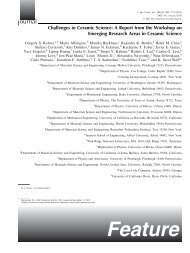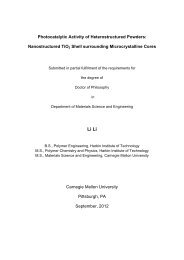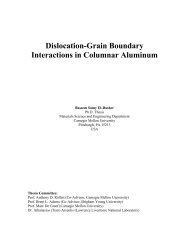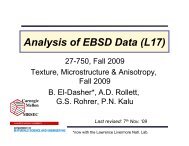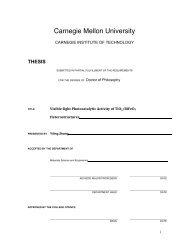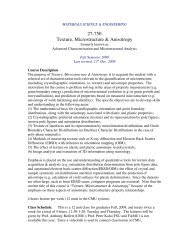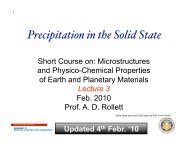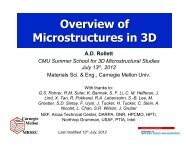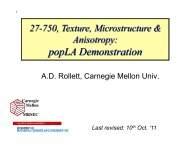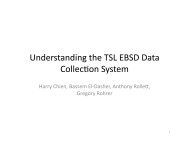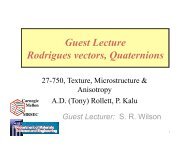¶ 3. Mathematical Representation of Crystal Orientation, Misorientation
¶ 3. Mathematical Representation of Crystal Orientation, Misorientation
¶ 3. Mathematical Representation of Crystal Orientation, Misorientation
Create successful ePaper yourself
Turn your PDF publications into a flip-book with our unique Google optimized e-Paper software.
misorientation in global coordinates by performing the inverse transformation (from<br />
crystal to reference frame) so that ∆a global = a1 T a2.<br />
<strong>3.</strong>L.6 Effect <strong>of</strong> <strong>Crystal</strong> Symmetry on <strong>Misorientation</strong><br />
Now that we have established our definitions <strong>of</strong> misorientation, we can look at the<br />
effect <strong>of</strong> symmetry operators. As before, we consider axis transformations first. Writing<br />
crystal symmetry operators as O, we can write the general misorientation as follows,<br />
where O1 is the symmetry operator applied to the first crystal, and O2 is the (crystal)<br />
symmetry operator applied to the second crystal.<br />
∆a' = O2 a2 a1 T O1 T (<strong>3.</strong>M.6.i)<br />
The purpose here is to develop a method <strong>of</strong> finding all the physically equivalent<br />
relationships between two lattices. [Caution - boundaries require at least two more<br />
parameters in order to account for the inclination <strong>of</strong> the boundary, making five in total.]<br />
Since the crystal symmetry operators can be regarded as re-labeling the crystal axes,<br />
applying a symmetry operator to either crystal cannot change the physical nature <strong>of</strong> the<br />
lattice relationship, or, by implication, <strong>of</strong> the boundary between the two lattices.<br />
<strong>3.</strong>L.7 Switching Symmetry: Inversion <strong>of</strong> Rotation<br />
Note that since trace(a) = trace(aT) the rotation angle is invariant with respect to<br />
transposition <strong>of</strong> the rotation matrix. The rotation axis, however, reverses sign when you<br />
transpose the rotation matrix. Therefore we can write that a( ,θ) = a( ,-θ) T = a(- ,θ) T<br />
and that a( ,-θ) = a(- ,θ), or, a(- ,-θ) = a( ,θ). This result has an important physical<br />
consequence. A given boundary formed as ∆a = a2.a1 T cannot be physically<br />
distinguishable from the boundary formed by the transformation in the reverse sense, i.e.<br />
∆a' ← = → ⎯ a1.a2 T . However, ∆a = (∆a') -1 = (∆a') T r ˆ r ˆ<br />
r ˆ<br />
r ˆ r ˆ<br />
r ˆ r ˆ<br />
. Therefore the misorientations<br />
defined by a( r ˆ ,θ) and a( r<br />
ˆ ,-θ) are physically equivalent. In more physical terms, there is<br />
a switching symmetry, i.e. it does not make any difference to the boundary to switch the<br />
order in which the grains are considered for constructing the misorientation.<br />
This equivalence is useful when determining the fundamental zone in whichever space is<br />
used to describe misorientation. In the Rodrigues space, for example, the application <strong>of</strong><br />
the (24 x 24) symmetry operators on both orientations, as in<br />
∆a' = O2 a2.a1 T O1 T , (<strong>3.</strong>M.7.i)<br />
results in a fundamental zone that contains two unit triangles in terms <strong>of</strong> rotation<br />
directions. The switching symmetry, i.e. the equivalence <strong>of</strong> the positive and negative<br />
rotation axes means, however, that the two triangles can be further reduced to a single<br />
triangle. That is to say, two Rodrigues vectors that are equal in magnitude but opposite in<br />
direction represent physically indistinguishable grain boundaries. This is important in the<br />
determination <strong>of</strong> disorientation, <strong>3.</strong>M.9.<br />
8/27/09 32



